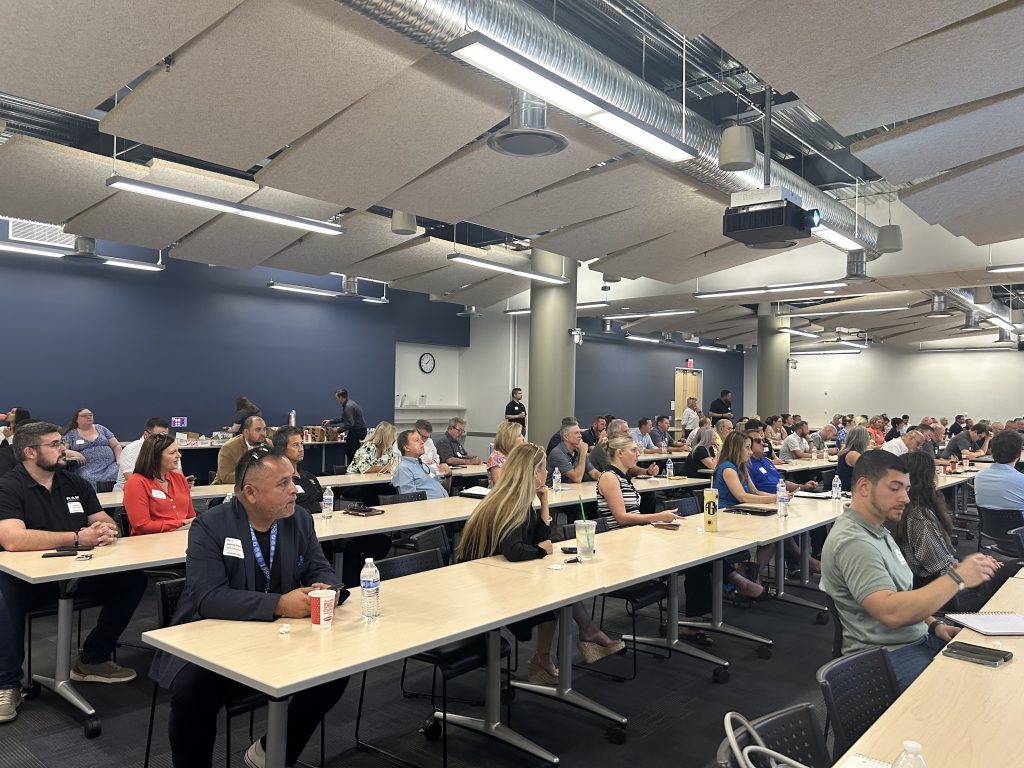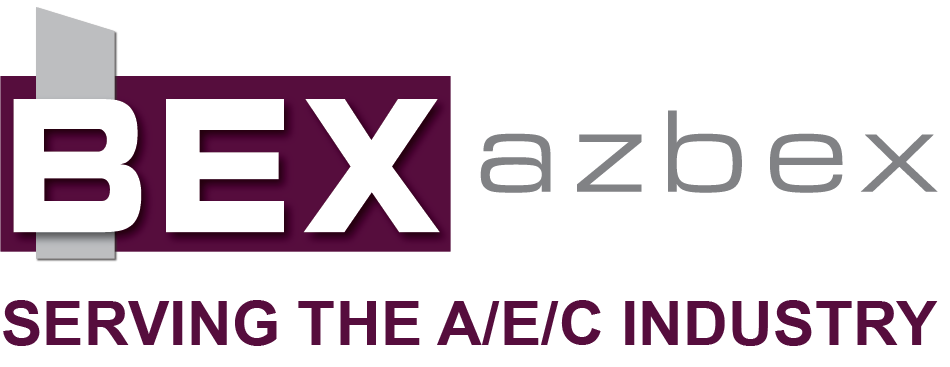By Aaliyah Koelzer for AZBEX

On Aug. 12, Industrial sector professionals from across the Valley gathered at SkySong Innovation Center to gain a deeper understanding of fundamentals driving Arizona’s Industrial development at the latest BEX Leading Market Series event.
Three of the most prominent players in the local market shared their thoughts on how the market is shifting, discussing headwinds and tailwinds that have remained prevalent throughout 2025.
The speaking panel featured:
- Peter Ledger; West Coast Division Director; Graydaze Contracting (Moderator);
- Rodney C. Boden; VP, Investment & Development; ViaWest Group, and
- Jonathan Teeter, Senior VP, CBRE.
Graydaze Contracting was the event sponsor.
The conversation kicked off with quick introductory statements from BEX Founder and President Rebekah Morris and then diverged into current exciting projects from each panelist.
Boden didn’t hesitate to begin sharing various projects currently completing development, highlighting the recent sale of Sight Logistics Park, a 350KSF industrial park in Tempe, as well as its sister project, Converge Logistics Center, which is in its final stages of leasing.
He went on to speak about a recent land sale along the I-10 in Buckeye, which will hold seven buildings totaling 300KSF once completed.
Teeter then jumped into the conversation, sharing that he specializes in the Mesa-Gateway Airport submarket, which has seen 3.5MSF of leasing activity through CBRE.
It didn’t take long for headwinds to come into conversation, with Teeter stating, “Vacancy is at 35% in Mesa; so it is probably the most struggling submarket we have in Phoenix right now.” Teeter blamed this vacancy on high levels of competition and low demand for certain sizes of industrial developments across the Valley, “Particularly the 100KSF to 200KSF size, which has typically been the bread and butter of Phoenix.”
1MSF Bombers: Are They Back?
In Q4 2024, there were nine buildings available in the 1MSF range in metro Phoenix. Today, only two remain available.
“I think you are going to see an increase in development in bigger boxes, primarily along the 303,” Teeter said.
This comes as a surprise, as the market steadily shifted away from these large-scale users throughout 2024 in an attempt to curb rising vacancy. However, with major tenants suddenly scooping up nearly all the large box space in the valley, there are signals that large box demand is bouncing back.
Boden gave his thoughts on Amazon’s leasing activity over the past year, stating, “The term we use is ‘Counter-Cyclical.’ Amazon keeps an eye on when vacancy is high in order to time the market and get the best lease rates possible.”
Amazon undertook a massive leasing initiative in 2024, taking 3MSF. This counter-cyclical strategy, capitalizing on high vacancy to secure favorable leases, shows potential for strong future demand for big-box developments.
Municipal Policies and the California Effect
Moderator Ledger was the first to strike at understanding the effect California business migration has had on the Arizona Industrial development market, saying California has continued to put up so many restrictions and so much red tape around industrial development, it continues driving business to Arizona.
Boden was quick to agree, explaining that as businesses flee California’s restrictive regulations, cities such as Buckeye, Glendale, and Surprise are capitalizing on pro-growth policies.
Glendale’s proactive engagement and Surprise’s supportive development stance enhance their appeal. “Right now, I think Glendale is really engaged in a high-growth mindset, particularly in the 303 corridor,” Boden said.
Meanwhile, Mesa’s restrictive policies in the Mesa-Gateway area, favoring smaller buildings in the 100KSF-200KSF range, have led to an oversupply of similar designs, exacerbating vacancy rates. These policies leave potential large manufacturers and their suppliers struggling to find suitable spaces in Mesa, while also boxing out tenants in need of smaller spaces.
Boden finalized this point by saying, “Mesa has taken a stance that big boxes and data centers are no good. They really only want to see 200KSF buildings or smaller”.
Infrastructure Challenges and Data Center Impacts
Along with development size, Mesa has also restricted data center development through new zoning regulations in an attempt to curb the perceived potential negative impact data center developments may have on municipalities.
Data centers, while boosting municipal tax revenue, pose significant challenges by consuming prime land and straining power resources.
Teeter explained his thoughts on the issue, stating, “They are taking up land designated for high employment, when there are very few people actually showing up to work in these buildings.”
With more resources to spend on purchasing land and construction, data center developers have become a driving element of Arizona’s Industrial market, and they are out-competing manufacturers and distributors.
A major downside to massive data center growth is the current and future strain on the power grid. These effects are already being seen in the Valley. “If you’re a data center group and you ask APS or SRP to deliver power to your site, they are going to tell you it will take 13 years until you can get your power,” Boden warned.
He went on to explain that the real issue with power is not the supply, but the transmission to where it is needed. In turn, data center developers have found clever ways around the power struggle. “Nobody can give data centers all the power they need today, but there are plans in place to get the ball rolling. Phasing the power needed over an extended timeline is one way to get these data centers moving and operational,” Boden explained.
Under this system, data centers and, to a large extent, advanced manufacturers, work with the utility provider to establish how much power will be needed to successfully begin operation and set a progressive timeline to increase power availability over multiple phases.
Closing Statements: Ending on a Win
The discussion took a more positive turn when moderator Ledger pointed to lower construction costs being seen in the Valley.
Boden was first to concur, saying “Compared to the past couple of years, we’re seeing a 15-20% decline in construction costs.” He went on to highlight the relief developers have felt seeing projects able to pencil again, with declining construction costs countering rising land prices.
Teeter agreed that lower construction costs are a welcome trend to keep industrial development feasible and offset land cost inflation, saying, “We have these mega-projects and data centers that are willing to overpay for land, driving up land prices and diminishing the market for speculative industrial building.”
Along with praising favorable lower construction costs, the panelists ended the session with upbeat outlooks for Arizona’s industrial market as a whole. “Phoenix is very strong and very resilient. There are still a lot of users coming in, and opportunity is still in the market,” said Teeter.
Boden seconded that, saying there is a great opportunity with infill developments that will continue to provide top end returns. Often in the years after peak performance, navigating the market can prove challenging. Fortunately, Arizona remains strong due to solid fundamentals and a robust Industrial real estate market.


